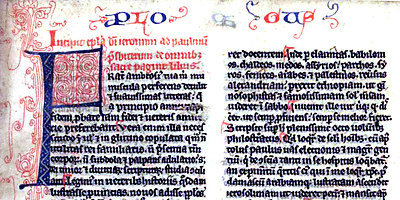
 COLUMBIA—Just months after it opened its Ernest F. Hollings Special Collections Library, the University of South Carolina has acquired a rare medieval Bible, the first complete piece of its kind in the state.
COLUMBIA—Just months after it opened its Ernest F. Hollings Special Collections Library, the University of South Carolina has acquired a rare medieval Bible, the first complete piece of its kind in the state.
Small enough for monks and friars to tote around, the new Bible is rare because it was written in Oxford, England, around 1240 and is in pristine condition, according to a press release from the university.
It was purchased for $77,000 with support from New York’s B.H. Breslauer Foundation and joins other medieval holdings in the library’s Irvin Department of Rare Books and Special Collections.
Scott Gwara, Ph.D., a USC medievalist who recommended the acquisition and secured the outside funding, said the Bible is exceptionally fine. He said most medieval Bibles in the United States, fewer than 100 in number, are from France or Italy.
“Most Bibles from this period originated in Paris, so an English Bible like this one is very rare,” he said. “It looks as pristine as the day it was copied, more than 750 years ago.”
Gwara said USC acquired the piece for many reasons.
“Simply put, the Bible is the most important book in the Western world,” he said. “This one happens to be a fabulous teaching aid. Pocket Bibles are innovative … they enabled clergy to have the Bible in a single, portable volume. In England, traveling friars from either the Dominican or Franciscan orders would likely have carried a Bible such as this.”
He said the medieval tome isn’t dissimilar from Bibles today, with its thin pages, tiny handwriting and comprehensive chapter numbers.
The book is about 7 inches tall by 5½ inches wide. The English vellum, a parchment made from animal skin, has a delicate suede-like feel to the touch. Dozens of intricately decorated initials, written with a reed pen in blue with white zigzags, open each book.
The text is penned at a size comparable to a four-point type today, which is roughly half the size of newspaper print.
While the ornate lettering is eye-catching, the true beauty in the pocket piece is in its texts, he said.
“It’s nothing like the Paris Bibles of the period,” he said. “Generally, these 13th-century Bibles included prefaces to each book. This Bible has far more prefaces than normal and features a pastor’s notes and proofreading marks in its margins. It also includes a text called the ‘Interpretation of Hebrew Names,’ which translates the Hebrew names in the whole Bible.”
The pocket Bible is the second medieval manuscript the university acquired. Gwara said there are fewer opportunities to purchase ancient texts through auctions because most manuscripts have already been acquired by libraries, museums and private collectors.
“The market for medieval holdings is finite, and it’s drying up,” he said.
Gwara said a complete Missal and Breviary, a book of prayers and hymns — two essential manuscripts at a cost of approximately $7,500 each — would enhance USC’s teaching collection.
The English pocket Bible will be featured in an exhibit that will open in the spring at the Hollings Library. To see USC manuscript collections, visit www.pagesfromthepast.org.
